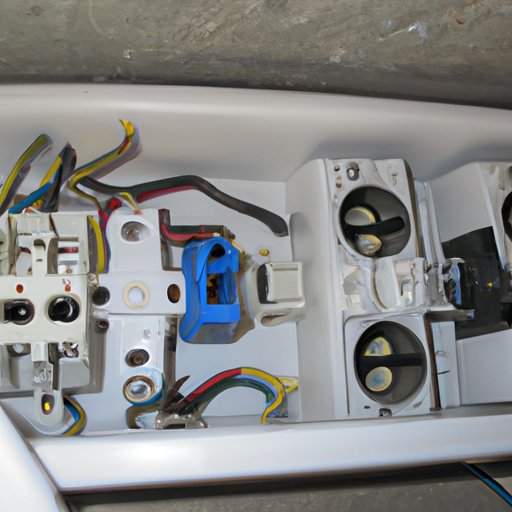Introduction
When your washing machine won’t turn on, it can be a huge inconvenience. It’s important to troubleshoot the problem to determine what’s causing it so you can get your washer working again. This article will provide an overview of the common causes of a non-functioning washer and simple solutions for fixing it.
Troubleshooting Steps to Diagnose and Resolve a Non-Functioning Washer
Before attempting to repair your washer, it’s important to diagnose the problem. Here are some steps you can take to identify the cause of your washer not turning on:
Check the power cord: Make sure the power cord is securely plugged into the wall outlet and the back of the washer. Check for any damage or fraying in the cord. If the cord appears to be damaged, replace it.
Test the outlet: Use a multimeter to test the wall outlet for voltage. If there is no voltage, check the circuit breaker or fuse box to make sure the outlet isn’t tripped or blown.
Check the fuse or circuit breaker: If the wall outlet has no power, check the fuse or circuit breaker to make sure it hasn’t been tripped or blown. If it has, reset it or replace the fuse.
Inspect the wiring: Inspect the wiring between the wall outlet and the washer for any signs of damage or loose connections. If the wiring appears to be damaged, it should be replaced by a professional.
Common Causes of a Washing Machine That Won’t Turn On
Once you’ve completed the troubleshooting steps above, it’s time to identify the cause of the problem. Here are some of the most common causes of a washer that won’t turn on:
Malfunctioning power cord: The power cord may be damaged or frayed, preventing it from providing power to the washer.
Faulty outlet: The wall outlet may be faulty, preventing the washer from receiving power.
Blown fuse or tripped circuit breaker: The fuse or circuit breaker may have been tripped or blown, preventing the washer from receiving power.
Loose or damaged wiring: The wiring between the wall outlet and the washer may be loose or damaged, preventing the washer from receiving power.
How to Identify the Problem When Your Washing Machine Won’t Start
Now that you know the common causes of a washer that won’t turn on, it’s time to identify the specific cause of the problem. Here are some steps you can take to identify the source of the problem:
Observe any lights or indicators on the washer: Some washers have lights or indicators that indicate when the washer is receiving power. If these lights are off, then the washer isn’t receiving power.
Listen for any sounds from the washer: If the washer isn’t receiving power, then it won’t make any noise when you attempt to start it.
Attempt to start the washer: Attempt to start the washer. If it won’t start, then the washer isn’t receiving power.
What to Do When Your Washing Machine Won’t Power On
If your washer won’t turn on, then it’s important to take the necessary steps to fix the problem. Here are some steps you can take to resolve the issue:
Check the power cord, outlet, fuse, circuit breaker and wiring: Follow the troubleshooting steps above to check the power cord, outlet, fuse, circuit breaker and wiring. Replace or reset any components that are not functioning properly.
Reset the washer: Unplug the washer from the wall outlet and wait 30 seconds before plugging it back in. This may reset the washer and allow it to receive power.
Contact a professional for assistance: If you’re still unable to identify the cause of the problem, contact a professional for assistance. A qualified technician can diagnose the problem and provide the necessary repairs.
Simple Solutions to Fix a Washer That Won’t Start
Once you’ve identified the cause of the problem, you can take the necessary steps to fix it. Here are some simple solutions for fixing a washer that won’t start:
Replace the power cord: If the power cord is damaged or frayed, replace it with a new one.
Replace the outlet: If the wall outlet is faulty, replace it with a new one.
Replace the fuse or reset the circuit breaker: If the fuse or circuit breaker has been tripped or blown, replace the fuse or reset the circuit breaker.
Check the wiring connections: Check the wiring connections between the wall outlet and the washer for any signs of damage or loose connections. If the wiring appears to be damaged, it should be replaced by a professional.
Conclusion
When your washer won’t turn on, it can be a frustrating experience. To identify the cause of the problem, follow the troubleshooting steps outlined in this article. Common causes of a washer that won’t turn on include a malfunctioning power cord, a faulty outlet, a blown fuse or tripped circuit breaker, and loose or damaged wiring. Once you’ve identified the cause of the problem, take the necessary steps to fix it. If you’re unable to identify the cause of the problem or fix it yourself, contact a professional for assistance.


